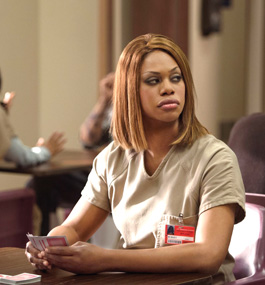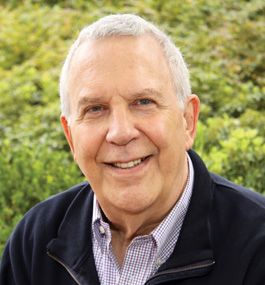Out and Proud On-Screen
From “The Boys in the Band” to “Orange Is the New Black,” Larry Gross ’64 has watched LGBTQ portrayals evolve in the decades since Stonewall.

©Netflix / Courtesy Everett Collection
DOING TIME: Laverne Cox played prison inmate Sophia Burset on Netflix’s “Orange Is the New Black,” becoming, in 2014, the first openly transgender actor to earn an Emmy nomination.
by Naomi Zeveloff
In June 1969, New Yorkers rioted to protest a police raid at a Greenwich Village gay bar called the Stonewall Inn. The six days of turmoil that became known as the Stonewall uprising marked a huge shift for the LGBTQ community. A new activism and openness took root and grew. Slowly, American culture began to change.
And the media took note of it all. In the pre-Stonewall era, there were no LGBTQ characters on prime-time television in the U.S. Today, according to GLAAD, an advocacy organization dedicated to accelerating LGBTQ acceptance through the media, there are 75, with dozens more on shows airing on streaming services.
A founder of the field of gay and lesbian studies, Larry Gross ’64 is one of the foremost chroniclers of the way the media changed before and after Stonewall. Gross, a professor and former director at the University of Southern California’s Annenberg School for Communication and Journalism, has written extensively about the media’s portrayal of sexual minorities.
His 2001 book, “Up From Invisibility: Lesbians, Gay Men and the Media in America,” meticulously tracks this history of representation, recounting the first time a gay man appeared on TV news in New York City (in 1958; the man wore a hood to protect his identity), the first lesbian kiss on TV (on “L.A. Law” in 1991), and other moments both helpful and harmful to the LGBTQ cause.
Representation matters, Gross writes in the book, because “this is a media-dominated society, and being left off the media’s center stage is a form of symbolic annihilation.”
Real versions of real life
Nearly two decades since the book’s publication, Gross says the media have had a largely positive impact on public attitudes toward LGBTQ individuals. Reality TV has played a big part, he points out. “The Real World,” which debuted on MTV in 1992, included gay and lesbian characters from the outset. Those casting choices made the show convincingly real to audiences and set the stage for future changes in TV programming.
In spite of a recent surge in regressive politics, Gross predicts that over the coming years we’ll see even more LGBTQ characters on television and in films. The Trump administration might chip away at hard-won gains for sexual minorities, he says, but it won’t succeed in turning the tide of representation in the media. The reason has to do with media fragmentation and the fact that mainstream outlets, by and large, cater to liberal audiences rather than Donald Trump’s base.
Although progress today “may be slower and more heated,” Gross says, “I think representation will continue to increase, because the mainstream media systems are still aimed at the younger, affluent, educated, more liberal portions of the population. So that is going to keep going.”
Gross, who lives in Los Angeles with writer and health activist Scott Tucker, his husband and partner of 44 years, was born in Washington, D.C. When Gross’ father, who worked in the Truman administration and at the Democratic National Committee, became a target of McCarthyism in the 1950s, he temporarily relocated his family to Israel, where he became an economic adviser to Israeli Prime Minister David Ben-Gurion and taught at the Hebrew University of Jerusalem. Gross attended an Israeli high school — he speaks Hebrew — but set his sights on going to a U.S. university.
Brandeis was one of three schools he applied to (as a teen, he had read “Motivation and Personality,” the seminal book by Brandeis psychology professor Abraham Maslow). He ultimately enrolled at Brandeis after his family received a chance visit by John Roche, an acquaintance of Gross’ father who was the university’s dean of the faculty of arts and sciences.
Roche “gave me the Brandeis pep talk,” Gross says.
‘A kibbutz with homework’
By the time Gross arrived on campus in 1960, the 12-year-old university was an intellectual powerhouse. He studied psychology with Maslow and art with legendary fine arts professor Léo Bronstein. A course Gross still teaches — Art, Artists and Society — is deeply influenced by Bronstein’s theories on how artistic style embodies worldview.
Overall, Gross found the campus a familiar environment. “Brandeis seemed to me to be like a kibbutz with homework,” he says.
His friend Temma Kaplan ’64, a founder of the field of women’s studies, describes early-1960s Brandeis as a playground for the intellectually curious. And Gross, she says, fully embraced the idea that “anything that came to you as a question was worth pursuing.”
Outside the classroom, Gross was involved in amateur theater, stage-managing performances at Cholmondeley’s. He also helped found a literary magazine, The Fantasy Echo. The name was an inside joke on campus, a reference to what many students thought they heard when English professor Allen Grossman, PhD’60, said the French term for “end of the century”: fin de siècle.
Gross was also politically active, regularly traveling to Washington, D.C., to demonstrate in favor of civil rights and the nuclear test ban treaty and, later, to protest the Vietnam War.

Larry Gross ’64
page 2 of 2
He was not out while he was at Brandeis, he says, nor were there organized campus groups for LGBTQ students at the time.
After Brandeis, Gross went to graduate school at Columbia University, then became a faculty member at the University of Pennsylvania’s Annenberg School for Communication, the sister program to the school at USC.
At Penn, Gross was part of the Cultural Indicators Project, which monitored television programming and analyzed its impact on the way people perceived reality. Along with project founder George Gerbner, he developed the idea known as “cultivation theory,” which suggests that the more time people spend watching TV, the more they believe reality comports with what they are seeing on TV.
In the 1970s, as the LGBTQ movement was gaining steam, Gross saw how influencing the media could help change the discourse around LGBTQ Americans. “In the early days of this movement, it was pretty clear the media were a necessary focus,” he says. “You weren’t going to change society and social attitudes unless the media were changed, unless they were part of the solution instead of being part of the problem.”
Gross co-chaired the Gay and Lesbian Task Force of Philadelphia, which made media activism a priority. “We worked to influence newspapers, radio and television managers, editors and reporters to change the nature of media coverage,” he says.
Invisible no more
The task force pioneered the use of public service announcements to raise awareness of discrimination against LGBTQ Philadelphians. One ad caused a stir. It featured a young man standing in front of the city’s Walt Whitman Bridge, saying he wished he had learned in high school that Whitman was gay. According to Gross, the local stations refused to air the ad because Whitman “wasn’t around to defend himself.” When the task force held a press conference denouncing the stations’ refusal, the ad was shown on TV news reports.
In the past, Gross says, “if you wanted to influence the media you had to influence that group in the center, which is what activists did. You persuaded them, you cajoled them, you threatened them, you pointed out that their son is gay or their sister is a lesbian or whatever, and they should think twice. Or you outed them.”
Today, the nature of media activism has changed because the media have changed. Now the internet has elevated activist voices. It has also helped LGBTQ people find each other. “Isolation of the sort that was experienced by young LGBTQ people in the past is now not as common,” says Gross.
As LGBTQ representation in the media increases, Gross is watching closely — and with some skepticism. The proliferation of trans characters on shows — Sophia Burset on “Orange Is the New Black,” for instance, or Maura Pfefferman on “Transparent” — could signal real change, or it could be a trend, he says.
In Gross’ words, here’s what today’s Hollywood writers might be thinking: “We can take out our tired, old, familiar plotlines, and this time run them with a trans character — whereas 40 years ago, we ran them with a black character, then with a woman character and then a gay character.”
Now in his 70s, Gross describes activism as the “territory of the young.” He urges young LGBTQ activists to focus on making changes within the realm of education. Americans learn through two “curricular systems,” he says: the informal one, or mass media, and the formal one, or mandated education. Recently, New Jersey became the second state after California to mandate that LGBTQ history be taught in its public schools. None of the other 48 states has such a law on its books.
“The experience of most minorities at the hands of the educational establishment has typically begun with invisibility, followed by demeaning and stereotypic portrayals,” says Gross.
“The struggle for change begins with a demand for inclusion, on terms that recognize the humanity, the value and the contributions of all segments of American society.”
Naomi Zeveloff is a freelance writer living in Tel Aviv.
